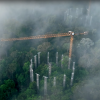
The AmazonFACE project addresses the overarching question of how climate change will affect the Amazon forest, the biodiversity it harbors, and the ecosystem services it provides to humanity.
Project goals
The central feature of the AmazonFACE project is a field experiment of unprecedented scope that exposes mature tropical trees to projected future CO2 concentrations in an old-growth Amazon forest stand located near Manaus, Brazil. The project uses Free-Air CO2 Enrichment (FACE) technology to increase our understanding of the functioning of the world's largest tropical forest in light of climate change and to apply the knowledge gained for steering regional policies on climate change mitigation and adaptation.
Objectives
Rapid changes in the Earth's climate caused by the burning of fossil fuels and deforestation pose a severe threat to forests of the Amazon basin. Warmer temperatures and drier conditions are predicted to cause widespread forest dieback, with associated threats to regional economies, social welfare, and natural capital through changes in agricultural output and hydropower supply. Nonetheless, the implications will be global as Amazon forests provide substantial services to all humankind by regulating the climate through the cycling of carbon, water, and energy; and harboring a large part of the world's biodiversity.
The impact of climate change on tropical ecosystems, however, is highly uncertain. Reducing this uncertainty is critical for global assessments of ecosystem vulnerability to climate change and for steering development policies for the Amazon region under future climate change scenarios. To this end, the AmazonFACE project aims to resolve a key source of uncertainty: the potential impact of continuously rising atmospheric CO2 concentrations on Amazon forest resistance and resilience to drought. So far, the magnitude and duration of this supposed CO2 fertilization effect, which has been proposed to stimulate forest growth in tropical forests remains largely undetermined, despite its potential importance for the global carbon cycle, in buffering tropical forests against the deleterious effects of climate change.
A Free-Air CO2 Enrichment (FACE) experiment is the most direct and robust scientific approach for reducing this uncertainty. No such experiment has ever been attempted in a tropical forest, despite the long- standing recognition in science and policy communities of the need for such an experiment. The AmazonFACE experiment will provide us with new insights for model development, which should enable us to make more reliable projections of tropical ecosystem functioning under future scenarios.
Collaboration partners and scientific steering committee members
- Bart Kruijt (President) - Alterra Wageningen University, Netherlands
- Carlos Alberto Quesada (Vice-president) - National Amazon Research Institute, Brazil
- Henrique Nascimento - National Amazon Research Institute, Brazil
- Sabrina Garcia - National Amazon Research Institute, Brazil
- Alessandro Carioca de Araújo - Empresa Brasileira de Pesquisa Agropecuária, Brazil
- Bruno Takeshi Portela - Fundação Amazônica de Defesa da Biosfera, Brazil
- David M. Lapola - Universidade Estadual de Campinas, Brazil
- Tomas Domingues - Universidade de São Paulo, Brazil
- Richard Norby - Oak Ridge National Laboratory, USA
- Iain Hartley - University of Exeter, UK
- Martin De Kauwe - University of New South Wales, Australia
- Anja Rammig - Technical University of Munich, Germany
- Thorsten Grams - Technical University of Munich, Germany
- Katrin Fleischer - Technical University of Munich, Germany
- Florian Hofhansl - International Institute for Applied Systems Analysis, Austria
Featured articles
Hofhansl, F.; Andersen, K.M.; Fleischer, K.; Fuchslueger, L.; Rammig, A.; Schaap, K.J.; Valverde-Barrantes, O.J.; Lapola, D.M. Amazon forest ecosystem responses to elevated atmospheric CO2 and alterations in nutrient availability: Filling the gaps with model-experiment integration. Front. Earth Sci. 2016, 4, 19.
Pereira IS, Mendonça do Nascimento HE, Boni Vicari M, Disney M, DeLucia EH, Domingues T, Kruijt B, Lapola D, Meir P, Norby RJ, Ometto JPHB, Quesada CA, Rammig A, Hofhansl F. Performance of Laser-Based Electronic Devices for Structural Analysis of Amazonian Terra-Firme Forests. Remote Sensing. 2019; 11(5):510. https://doi.org/10.3390/rs11050510
Publications
Schaap, K.J., Fuchslueger, L., Hofhansl, F. , Valverde‐Barrantes, O., Quesada, C.A., & Hoosbeek, M.R. (2024). Intra‐annual dynamics of soil and microbial C, N, and P pools in a Central Amazon Terra Firme forest. Journal of Plant Nutrition and Soil Science 187 (6) 725-736. 10.1002/jpln.202300107. Blanco, C.C., Rius, B.F., Darela-Filho, J.P., Cardeli, B., Aleixo, I., Scheiter, S., Langan, L., Joshi, J., Hofhansl, F. , Singh, S., De Paula, M.D., Hickler, T., Ongole, S., Higgins, S., Fleischer, K., Rammig, A., Lichstein, J., & Lapola, D.M. (2024). Non-matching predictions from different models simulating the effects of elevated atmospheric CO2 on the Amazon forest’s functional diversity. DOI:10.5194/egusphere-egu24-22186. In: EGU General Assembly 2024, 14-19 April 2024, Vienna. Joshi, J., Hofhansl, F. , Singh, S., Stocker, B., Brännström, Å., Franklin, O. , Blanco, C.C., Aleixo, I., Lapola, D.M., Prentice, I.C., & Dieckmann, U. (2023). Competition for light can drive adverse species-composition shifts in the Amazon Forest under elevated CO2. BioRxiv 10.1101/2023.07.03.547575. (Submitted) Rius, B.F., Filho, J.P.D., Fleischer, K., Hofhansl, F. , Blanco Casagrande, C., Rammig, A., Domingues Ferreira, T., & Lapola Montenegro, D. (2023). Higher functional diversity improves modeling of Amazon forest carbon storage. Ecological Modelling 481 e110323. 10.1016/j.ecolmodel.2023.110323. Hofhansl, F. (2022). Amazon forest responses to projected climate change, elevated CO2 and biodiversity loss. In: Annual Meeting of the British Ecological Society (BES), 18-21 December 2022, Edinburgh, Scotland.
News

04 November 2024
